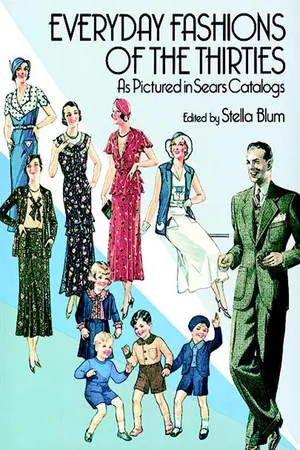
- 144 pages
- English
- ePUB (mobile friendly)
- Available on iOS & Android
Everyday Fashions of the Thirties As Pictured in Sears Catalogs
About this book
For thousands of women across America, hard hit when the frivolity of the twenties ended so resoundingly with the Crash of '29, the pages of the Sears catalog became an essential resource in maintaining a wardrobe. An ambitious marketing operation, it could not afford to take chances on haute couture; its fashions were geared as closely as possible to the prevailing tastes of the American people.
For this historically accurate sampling of authentic 1930s fashion, Stella Blum, former Curator of the Costume Institute at the Metropolitan Museum of Art in New York, selected for reproduction 133 representative pages from rare Sears catalogs of the period (fall and spring catalog for each year from 1930 to 1939). Hundreds of illustrations record what men, women, and children were actually wearing in the 1930s when, as a copyline from the Fall 1930 catalog proclaimed: "Thrift is the spirit of the day. Reckless spending is a thing of the past."
You'll see here how simpler women's fashion designs — of more traditional, affordable material — recaptured the feminine form with a more natural waistline and lower hemlines than seen in the twenties. For evening wear, longer dresses replaced flamboyant beaded short gowns while cloche hats, another twenties trademark, were replaced by berets, pillboxes, and turbans. The seriousness of the accessories and dresses endorsed by such Hollywood legends as Loretta Young, Claudette Colbert, and Fay Wray.
For historians of costume, nostalgia buffs and casual browsers, these pages afford a rare picture of how the average American really dressed during the thirties. It is an essential resource for study of the clothing of an important era which designers cannot afford to be without.
Frequently asked questions
- Essential is ideal for learners and professionals who enjoy exploring a wide range of subjects. Access the Essential Library with 800,000+ trusted titles and best-sellers across business, personal growth, and the humanities. Includes unlimited reading time and Standard Read Aloud voice.
- Complete: Perfect for advanced learners and researchers needing full, unrestricted access. Unlock 1.4M+ books across hundreds of subjects, including academic and specialized titles. The Complete Plan also includes advanced features like Premium Read Aloud and Research Assistant.
Please note we cannot support devices running on iOS 13 and Android 7 or earlier. Learn more about using the app.
Information
Publisher’s Note
Table of contents
- DOVER BOOKS ON FINE ART
- Title Page
- Dedication
- Copyright Page
- Table of Contents
- Publisher’s Note